|
BAP Precision S-Series
A high-precision rugged handheld for mobile data collection and communication
(by Conrad H. Blickenstorfer with photography by Carol Cotton)
There are many jobs that require some sort of heavily ruggedized handheld computer. In this report RuggedPCReview.com is analyzing one such handheld, the BAP Precision S-Series, made available by F4 Tech, a Tallahassee, Florida, based company that produces and distributes forest inventory technology for foresters across the United States, from software to rugged mobile field computers and GPS devices. F4 is now expanding into additional industries, and that's why they added the S-Series handheld to their lineup. F4 considers the device the next generation of high-precision handhelds for an increasingly mobile workforce.
I should point out right upfront, though, that in the realm of rugged vertical market handhelds, the term "next generation" refers more to a fortuitous convergence of tried and true components than the breakneck pace of advance in consumer smartphones. For now, industrial handhelds are an entirely different market and type of device, with cross pollination from the smartphone side of things just appearing on the horizon.
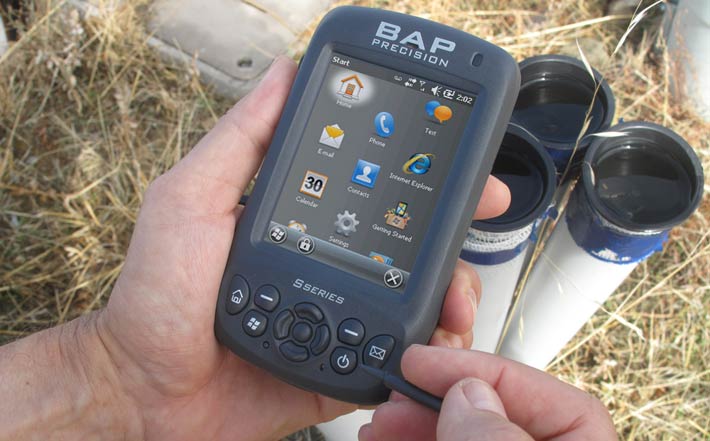
F4 Tech and the S-Series
To understand the S-Series handheld and its place in life, one needs to understand companies like F4 Tech. These are usually solutions providers that specialize in a certain field where they are experts. Solutions, applications and training generally work best if they are packaged and sold as hardware/software combinations. That's because, this way, if something goes wrong, the customer knows where to go and the vendor is familiar with both the software and hardware. The challenge for the solutions provider then becomes to procure hardware that's suitable for the application both in terms of capabilities as well as economics.
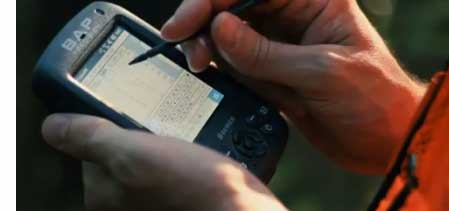 In F4 Tech's case, the company is packaging forestry software such as SilvAssist 2.0 (an extension to ESRI's ArcGIS), the TCruise forest inventory package, and mobile software such as RTI (real time inventory) running on top of Trimble's SOLO applications. It's no surprise, then, that F4 uses some of Trimble's mobile hardware, such as the Nomad, Ranger, Recon and Yuma. These, however, are all rather high-end systems, and so F4 Tech decided to explore additional alternatives. In F4 Tech's case, the company is packaging forestry software such as SilvAssist 2.0 (an extension to ESRI's ArcGIS), the TCruise forest inventory package, and mobile software such as RTI (real time inventory) running on top of Trimble's SOLO applications. It's no surprise, then, that F4 uses some of Trimble's mobile hardware, such as the Nomad, Ranger, Recon and Yuma. These, however, are all rather high-end systems, and so F4 Tech decided to explore additional alternatives.
Enter the S-Series. It's the first product of newly-formed BAP Precision, which is headquartered in Corvallis, Oregon, and has Asian offices as well. BAP, however, is not your conventional startup as its principals have extensive rugged mobile computing experience. We're not sure about how it all came about, but it's often the case that a group of likeminded individuals take a new direction to make a better product. In this case, their quest was for a mobile device with a powerful, yet frugal CPU, high performance/high accuracy GPS, tough enough to hold up outdoors but small and light enough to be carried around, and whatever communications options needed to do the job. Particular emphasis was on enabling real time, high accuracy post processing.
So what did they come up with? A rugged Windows Mobile-based Pocket PC-style handheld measuring a modest 3.1 x 5.5 x 1.2 inches and weighing about 11 ounces. The resistive touchscreen display measures 3.5 inches diagonally and offers 240 x 320 pixel QVGA resolution. The device is designed to be operated with a small stylus, has a 3-megapixel camera, u-Blox GPS with an external antenna connector, and good expandability. It can be equipped with GSM-based data and voice.
Design and construction
The BAP S-Series handheld uses a simple, ergonomic, ruggedized Pocket PC type of design. It's meant to be held in one hand and operated with the other. The housing, which is all curves and devoid of any sharp edges or corners, is made of tough plastic with a matte gray finish. There aren't any protective bumpers as the design does not need them.
Below you can see the front and all four side views of the BAP Precision S-Series rugged handheld:
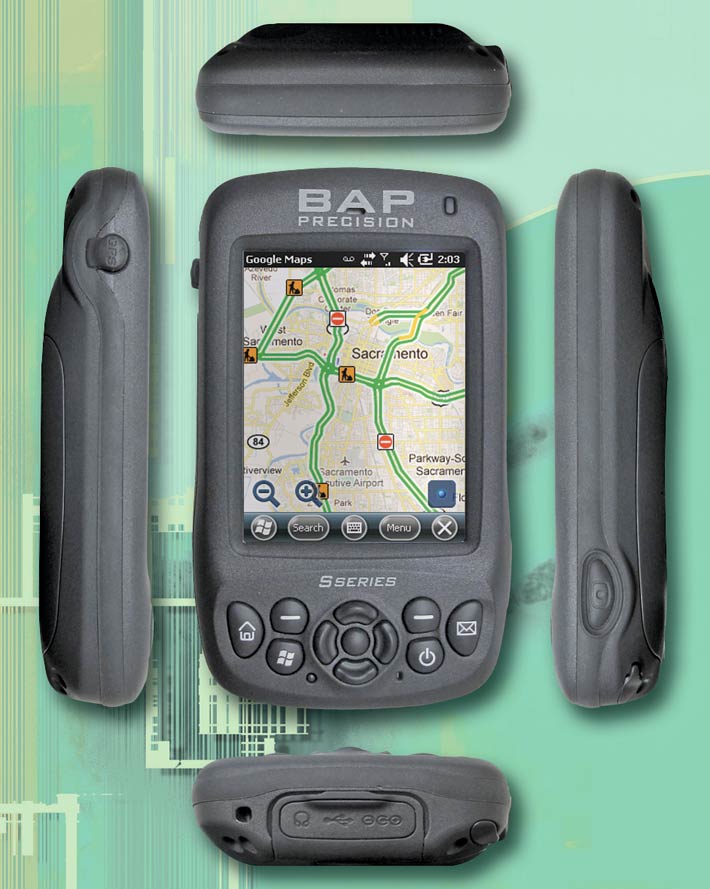
As has been the custom with Pocket PC-style Windows Mobile devices for well over a decade, BAP designed the S-Series handheld with just a navigation diamond, four function buttons, and two assignable softkey buttons. As we shall see later, the interior design is such that it could support a keypad or keyboard, but for now this is the only version offered. With the exception of the external GPS antenna port on the upper left side, all external connectivity is combined in one location at the bottom of the unit. Ports are as follows (from left to right):
- Headphones
- Micro USB (host and client)
- Power
Note that, unlike almost all current smartphones, the BAP S-Series is clearly designed to be used with a stylus and the few function buttons. While it's a touch screen, the resistive kind is meant to be used primarily with a stylus, though the version of Windows Mobile installed on the device allows for limited finger touch operation.
Below is a closeup of the unit's hardware controls. They are large enough to be used with gloves and they provide very good tactile feedback.
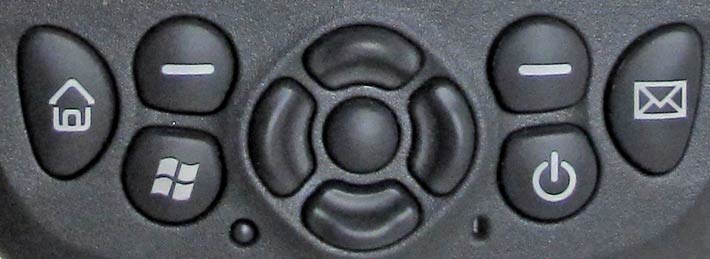
A look inside
When you open a rugged handheld, you never know what you're going to find inside. Early rugged products often looked like science projects. Those days are, for the most part, long gone, but there's still considerable variation in the design and quality of what's inside a rugged handheld computer even today. In our book, that means it's always good to know what's under the hood.
Turns out, the BAP Precision device has nothing to hide. Almost everything is as neat and clean as can be.
The device consists of two plastic halves held together by six small Torx screws. After the bottom half, which contains the battery compartment, is removed, you can see the unit's primary circuit board that takes up all of the interior real estate. It's an exceptionally clean board without any hanging wires or fixes. We like to see that.
The motherboard is mounted to what first appears to be the front half of the unit but is, in fact, a very sturdy aluminum or magnesium frame (see picture below). The keypad and the display are shock-mounted onto the other side of this metal frame, making for what appears to be a formidably sturdy and well-protected structure. We're not sure if this is BAP's intention, but this design with a keypad circuitry separate from the motherboard easily lends itself for different keypad/board implementations.
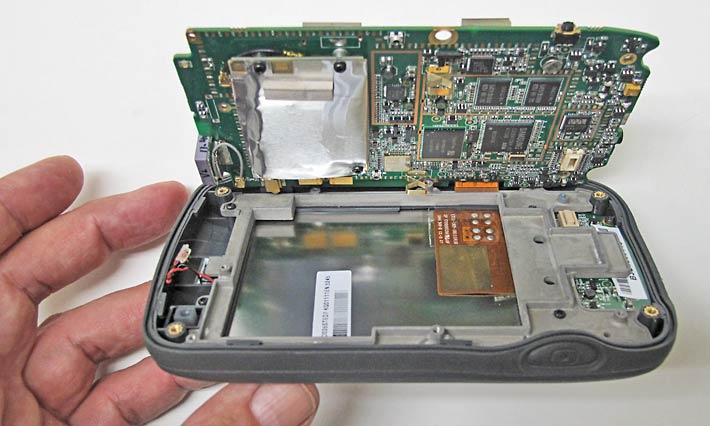
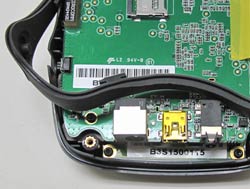 The two halves are sealed with a rubber/silicone ribbon that provides o-ring style sealing (see picture to the right). In terms of protection, the silicone ribbon seal seems a good solution. It even covers the photo trigger button, and there are a number of T-shaped anchors that fit into cutouts in the front part of the housing. This shows excellent attention to detail. Care, though, must be taken in making sure the ribbon is seated properly before assembling the unit, else small parts of the lip can get crushed. The two halves are sealed with a rubber/silicone ribbon that provides o-ring style sealing (see picture to the right). In terms of protection, the silicone ribbon seal seems a good solution. It even covers the photo trigger button, and there are a number of T-shaped anchors that fit into cutouts in the front part of the housing. This shows excellent attention to detail. Care, though, must be taken in making sure the ribbon is seated properly before assembling the unit, else small parts of the lip can get crushed.
The battery compartment (see picture below), as is often the case in handhelds and tablets, has openings into the interior of the unit. This means that the battery compartment cover must provide a secure seal. BAP does that with a rubber pressure seal. The plastic cover securely snaps into place, but we'd be even happier with some sort of screw.
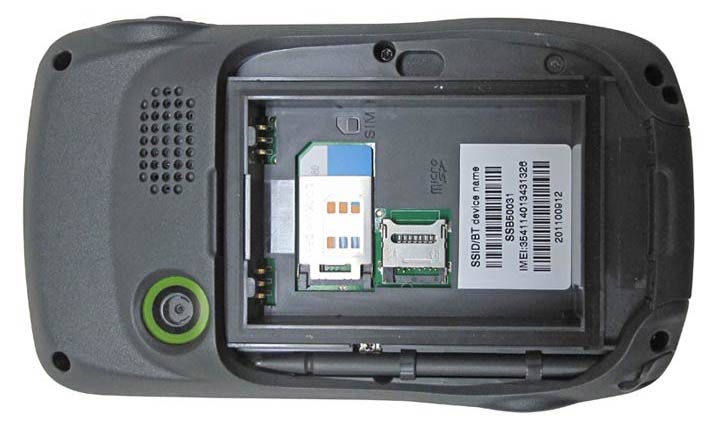
On the topside of the board you can see a number of surface-mounted components. Among them a u-Blox 50-channel LEA-6 series GPS module that can provide A-GPS services, one-second hot starts, is GLONASS/Galileo ready, and can reach SBAS accuracy of around 6-7 feet (see LEA-6 product summary). Below the GPS is the unit's tiny 3-megapixel autofocus camera. In the center of the board are the SIM card slot and a micro-SD card slot, both open towards the battery compartment. On the right side are edge-mounted power, USB and audio connectors.
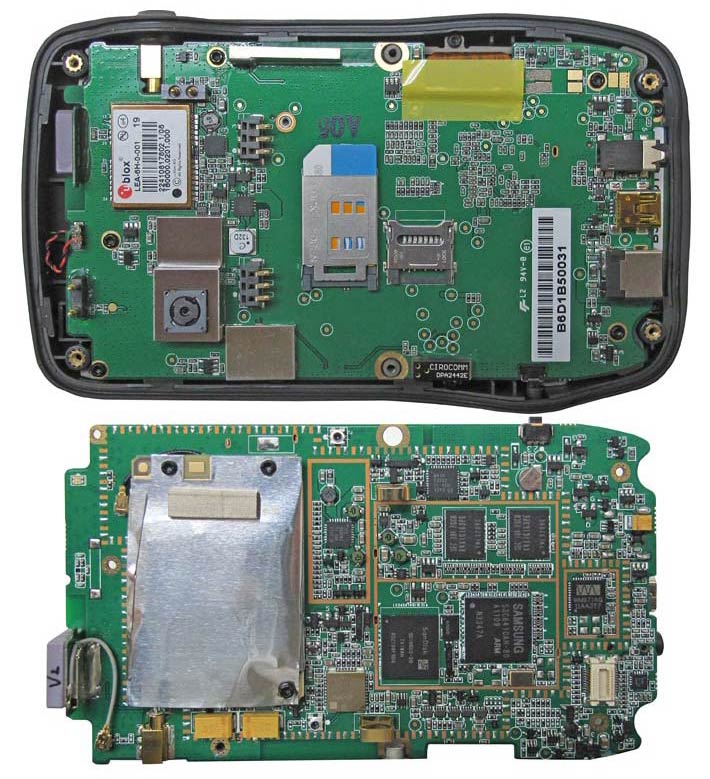
On the bottomside of the board is the Samsung S3C6410 processor, a 32-bit ARM11 RISC design with an AXI 64-bit bus and 3D hardware acceleration.This chip was specifically designed for next-gen handhelds with heavy-duty graphics applications. 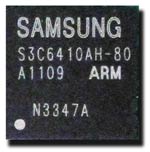 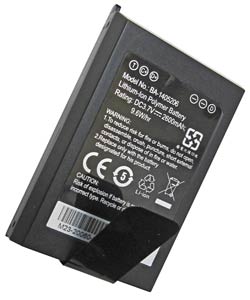 The chip has an integrated Multi-Format Codec that allows SD-quality video capture and playback at 30 frames/second as well as real-time video conferencing. The chip has an integrated Multi-Format Codec that allows SD-quality video capture and playback at 30 frames/second as well as real-time video conferencing.
Next to it is a SanDisk SDIN5D2-2G NAND Flash chip, the same as is found in such high profile products as the Galaxy Tab tablets or the Nook reader.
Wrapped in protective shielding on the left side is the wireless radio module. It is based on the Qualcomm MSM6280 chipset, a multimode solution supporting WCDMA (UMTS)/HSDPA and GSM/GPRS/EDGE (EGPRS).
The battery is a 3.7 Volt/2,600mAh Lithium Polymer design that looks like a larger digital camera battery. 9.6 watt-hours is perhaps a bit conservative for a device in this class, and we recommend carrying a spare. The design would also lend itself to accommodating a larger battery.
The bottom half of the housing has a garage for the 3-1/4 inch plastic stylus. Inside the garage is a small retainer spring to make sure the stylus doesn't fall out. The top of the stylus is shaped so that it neatly fits into a corner of the device, and there's a little beak to easily pull it out. Someone really thought this through.
Even though our review device was one of the very first production units, everything looked neat and clean inside (the WWAN wrapping could be a bit neater).
Operating System: Windows Mobile 6.5
At the time of the release of the BAP S-Series (mid-2011), the mobile operating system landscape is in flux. The S-Series handhelds run Microsoft Windows Mobile 6.5, and this requires a bit of explanation. Ever since the introduction of Apple's iOS and then Google's Android, expectations users have on how a smartphone, tablet, and handheld computer should work have fundamentally changed. Before the iPhone, mobile operating systems usually looked and felt like downsized versions of desktop operating systems. The iPhone showed that handheld operating systems can be sleek, fast, elegant and simple to use with projected capacitive digitizer technology that allows the softest touch as well as multi-finger operation for zooming, panning, etc.
Though updated to capture some of that more modern look and feel, Windows Mobile remains very different from those sleek, modern OS platforms. Initially conceived to battle the likes of the Apple Newton and the original Palm OS, the underlying Windows CE goes back a decade and a half. Windows CE was never elegant and, with the exception of a brief period of relative popularity in Pocket PCs, never successful in the consumer market. That's despite Microsoft offering competently integrated smartphone functionality in Windows Mobile years before the iPhone arrived.
As is, compared to iOS and Android, and even Microsoft's own Windows Phone 7, Windows Mobile looks crude and dated. The good news is that after all is said and done, there's still nothing that provides full and totally reliable interoperability with existing (Microsoft) enterprise infrastructure and enables the use of the ubiquitous Microsoft development tools thousands of programmers are familiar with.
Unfortunately, Microsoft has changed the names and nomenclature of the various versions of Windows CE so many times that only the most technical experts know which version is which, and how they all differ from one another. These days, Microsoft differentiates between Windows Embedded Handheld (formerly Windows Mobile, a term still used by BAP) and Windows Embedded Compact (formerly Windows CE). The latest version of the latter is Windows Embedded Compact 7, not to be confused with the rather sleek Windows Phone 7, which is a totally different development and not compatible in any way with either Windows Mobile nor Windows CE/Embedded Compact.
So why did BAP choose Windows Mobile 6.5? Probably because, for now, it remains a powerful, scalable 32-bit OS designed for intelligent devices ranging from enterprise tools such as industrial controllers, communications hubs, and point-of-sale terminals to consumer products such as cameras, phones, and home entertainment devices. It has Silverlight for Windows embedded, can use Flash Lite, Internet Explorer, Office apps, and a vast library of utilities and application software. It also remains the mobile OS of choice in several recently introduced devices by top-tier vendors such as Intermec, Motorola, Datalogic, etc.
For those somewhat familiar with Microsoft's numerous variations, keep in mind the difference between Windows Mobile 6.5 and 6.5.3. With the latter, Microsoft tried to modernize the look and feel of Windows Mobile by borrowing from the iPhone and also from their Zune music player, though underneath users will find much of the familiar Windows Mobile screens and functionality. Windows Mobile 6.5, which BAP chose, uses the same Windows CE kernel, but does not support swiping and multi-touch, and it has the older "classic" Windows Mobile Home screen that many prefer.
Look and feel of Windows Mobile 6.5
Below you can see some of the basic screens of Windows Mobile 6.5. On the left is the rather informative Home screen that provides a wealth of information and one tap access to often used functionality. The picture in the center shows the Start screen with its application icons and folders. To the right is Internet Explorer displaying part of a page on RuggedPCReview.com. Note the zoom slider that makes mobile IE a bit easier to use.
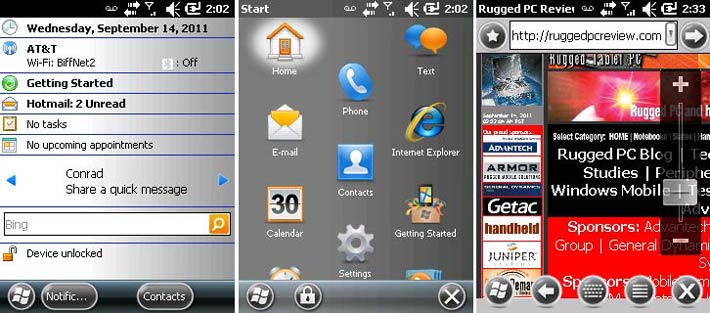
The BAP S-Series also comes with Office Mobile 2010. Microsoft has been offering these limited versions of its standard Office applications for many years, and whether you like them or hate them depends on how willing you are to accept limited functionality. I consider Mobile Word to be perfectly capable and useful, and Mobile Excel as well, though spreadsheets are more difficult to handle on a small screen. Mobile PowerPoint is really just a viewer. However, all three were able to handle all the Office files I threw at them. You also get the mobile versions of OneNote and SharePoint WorkSpace. In the middle is an example of Excel Mobile, and on the right a PowerPoint slide from a presentation I imported from a notebook computer.
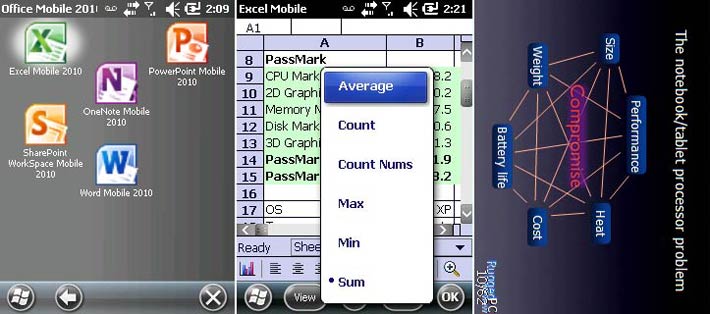
For data entry, the S-Series offers several options. You get to choose from two character recognizers. Letter Recognizer is reminiscent of "Jot," an early recognition system used on many Pocket PCs. The Block Recognizer (center) will be very familiar to those who remember Graffiti on early Palms. There is, of course, also the pop-up keyboard. Missing on our unit was Transcriber, perhaps the most popular of all handwriting recognition engines.
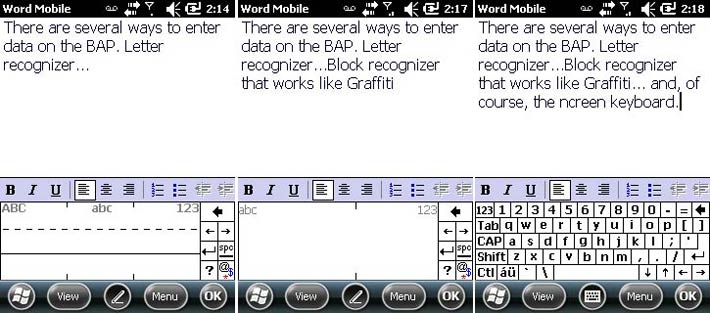
Google Maps (see below) is a free download from Windows Marketplace from where you can install apps directly onto your S-Series device. Since we didn't have any other GPS or GIS software installed, we checked GPS accuracy with Google Maps and routinely got to within three and ten feet accuracy. That's remarkable.
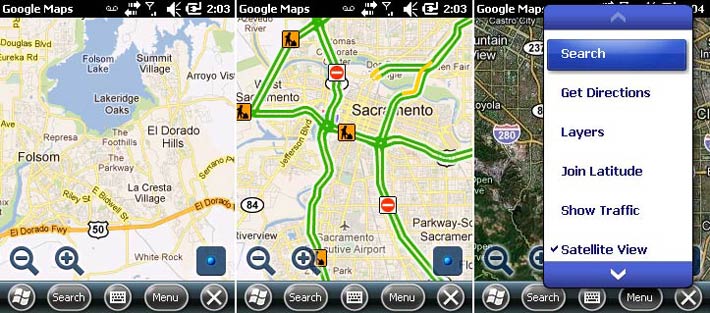
Below are some of the installed utilities. Windows Mobile has always excelled in providing numerous ways of fine-tuning, configuring, logging, etc., and a good number are available on the S-Series.
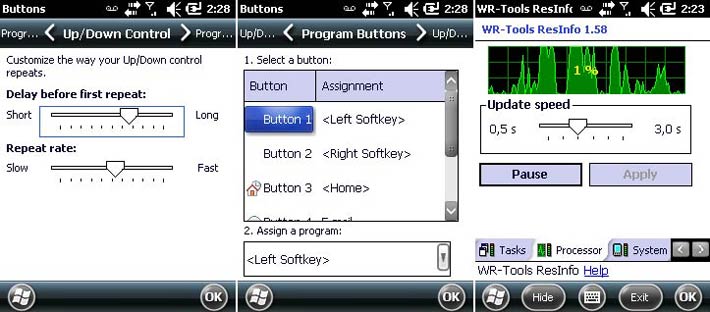
The S-Series can be configured as a phone as well. Our S850 model was, and, dare I say it, it actually sounded better than my personal iPhone. Microsoft nicely baked Windows Mobile phone functionality into the overall software, with excellent integration.
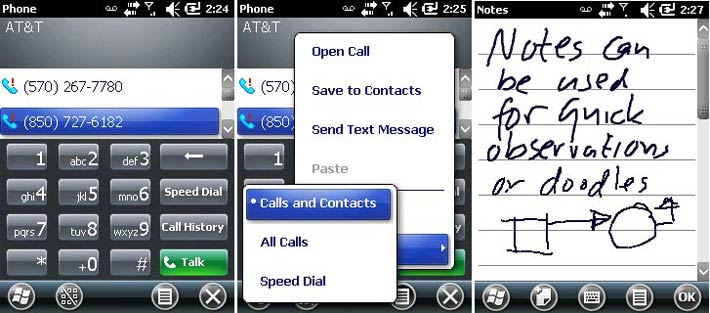
Below are a few more screens. To the left a look at Windows Marketplace which is far less developed than the Apple App Store, but still a great place to stock up on apps and utilities. In the center is AP Mobile, a news system we downloaded and installed on the S-Series. On the right is WindowsMedia.com, a portal for online streaming media.
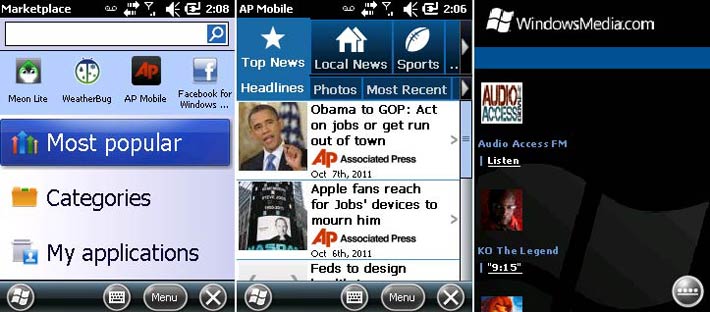
Camera
Like most handhelds and smartphones these days, the S-Series has an integrated camera. It's a 3-megapixel design that can take both pictures (up to 2048 x 1536 pixel) and video (only 320 x 240 pixel in our unit). That's not much in this day and age of smartphones with 8mp cameras capable of shooting 1080p HD video, but it's par for the course in this class of ruggedized handhelds.
To access the camera you use the Windows Mobile Pictures & Videos > Camera application. Unlike some such handhelds that only have rudimentary settings capabilities, the S-Series allows date and GPS EXIF stamping, digital zoom (1/1.2/1.4/1.6X), exposure compensation, day or night exposure setting, white balance settings (auto, indoors, sunshine, cloudy), and more. The shutter of the autofocus camera is nicely sensitive and provides good feedback.
Picture quality is decent, and you can get as close as two inches to a subject. The camera is not fast, though, and video playback is slow as well, so don't leave your dedicated camera at home. The mediocre quality of cameras in vertical market handhelds has long been a pet peeve of ours; quickly shooting a high quality picture or film clip can be an invaluable part of outdoor jobs, and even average smartphones can do that.
The below pictures were taken in the highest 3mp resolution. To see the unretouched full-size pictures, click left, center, right.

Display and usability
Displays are almost always the Achilles heel of mobile devices that are being used outdoors. That's because the display technologies that provide the bright, rich color we've come to expect from indoor screens are very different from those used to make a screen viewable outdoors where it has to deal with far more reflections and much brighter light.
While notebook and tablet computer displays have improved dramatically over the past several years, industrial handheld displays haven't changed very much. That's true for the S-Series's display as well. It is bright enough and it's certainly very sharp and clear, without any of the annoying iridescence we've seen on some recently released vertical market devices. The folks at BAP used a transflective design that makes for good viewability indoors and decent viewability outdoors. The display becomes more difficult to view in strong daylight and in the sun, but it never washes out completely.
The display also has good viewing angles. The horizontal viewing angle, in particular, is nearly a perfect 180 degrees, whereas the vertical viewing angle, though also wide, goes through some variations. The biggest problem outdoors are the reflections from the very glossy touch screen surface. That's exacerbated by the fact that resistive touch screens are not glass-flat, making for even more distracting reflections.
In terms of usability, the display is fairly deeply recessed into its bezel. This would be an issue if it were a finger-operated touch screen. Since the device is designed to be used with a stylus, the bezel is no problem. What we do regret is that BAP chose to go with a rather low-res QVGA 240 x 320 pixel display. For the S-Series' intended use in mapping and GIS, full VGA (480 x 640 pixel) would have been preferable, and according to F4 Tech, that's on the product roadmap.
Ruggedness
The primary reason why companies like F4 Tech install their software on devices like the BAP S-Series is their ruggedness. That's what differentiates them from standard issue consumer products (well, that and support and warranty!).
As is, the S-Series feels exceedingly sturdy and trust-inspiring. Its plastic body with its internal frame is rock-solid. The housing doesn't look like it'll scratch easily and there's nothing to dent.
In terms of ruggedness specs, the BAP S-Series has an extremely wide operating temperature range of -4 to 140 degrees Fahrenheit, which means it can be operated in just about any kind of environment, including commercial freezers.
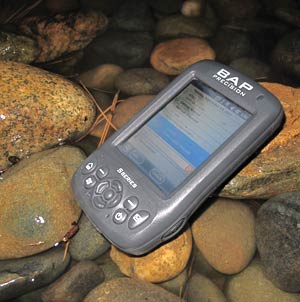 The S-Series handhelds are sealed to IP65 specifications, where the "6" (the highest rating) means total protection against dust, and the "5" means it is also protected against low pressure water jets from all directions. A F4 Tech representative we discussed the unit with felt that the rating was probably on the conservative side, and as long as the rubber plugs are firmly in place, we think an S-Series unit would probably survive even a drop into a shallow stream or ditch while on the job. The S-Series handhelds are sealed to IP65 specifications, where the "6" (the highest rating) means total protection against dust, and the "5" means it is also protected against low pressure water jets from all directions. A F4 Tech representative we discussed the unit with felt that the rating was probably on the conservative side, and as long as the rubber plugs are firmly in place, we think an S-Series unit would probably survive even a drop into a shallow stream or ditch while on the job.
The S-Series has been drop-tested per IEC 68-2-27 and can survive four foot drops onto steel. We have no reason to doubt that. The device has also been vibration and tumble tested, with the tumble test results especially impressive (1,000 times onto a hard surface from half a meter).
We did not see ESD and regulatory permissions data, so those interested in this unit should inquire with 4F Tech.
Available configurations
F4 Tech offers the BAP Precision S-Series handheld in four different configurations. There are two basic S810 models that run Windows Mobile 6.5 Classic. The primary difference between "Classic" and "Professional" is that the latter includes phone functionality. The basic model (US$849) has just Bluetooth, whereas the the US$1,099 model comes with WiFi and GPS.
For those who need WWAN functionality, there are two S850 models. They come with Bluetooth, WiFi, GPS and camera, but add the WWAN module. There is a data-only version (US$1,499) and a top-of-the-line voice/data version (US$1,699).
Bottom line: BAP Precision S-Series from F4 Tech
Despite consumer smartphones increasingly being used in applications that were once the exclusive domain of purpose-designed ruggedized handheld terminals, there are still numerous deployments where environmental conditions, potential abuse, IT security requirements, etc., make a traditional ruggedized PDA-style mobile computer a better choice. The Windows Mobile-based BAP Precision S-Series is such a device.
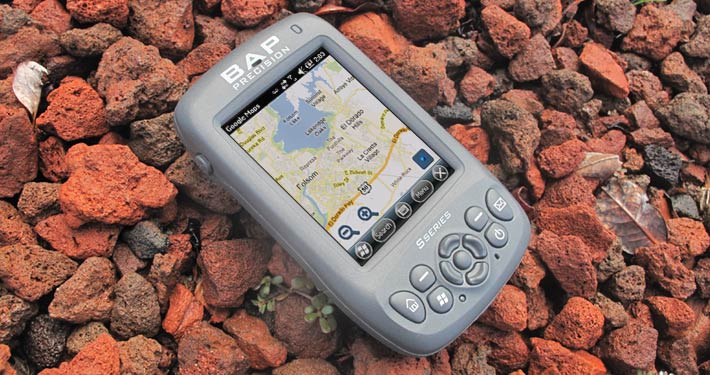
Based on field-proven technology, the S-Series merges Windows Mobile functionality, good performance and battery life, data capture, wireless communication, and very good GPS performance into a handy, sturdy device that weighs just 11 ounces. The 3.5-inch resistive touch display remains readable outdoors, though we'd like to see higher resolution and less reflection. If configured as a phone, voice quality and phone functionality are excellent.
In terms of ruggedness, the ergonomically designed BAP S-Series can take a beating. It looks and feels like a reliable tool for the job.
-- Conrad H. Blickenstorfer, October 2011
|
F4 Tech BAP S-Series Specifications
|
| Added/changed |
Added 10/2011
|
| Type |
Rugged handheld computer
|
| Processor |
800MHz ARM11 Samsung S3C6410 |
| OS |
Windows Mobile 6.5 Professional |
| GPS |
50-channel u-Blox LEA-6 GPS (GLONASS/Galileo ready); in our testing 3-10 feet accuracy with Google Earth |
| RAM/ROM |
256MB SDRAM/2GB NAND FLASH |
| Display |
3.5" transflective color TFT with QVGA (240 x 320 pixel) resolution |
| Digitizer/Pens |
Resistive touchscreen |
| Keyboard/keys |
Onscreen |
| Navigation |
Stylus/touch/navigation diamond, function keys |
| Expansion slots |
1 micro-SDHC (up to 32GB) Card slot inside battery compartment, 1 SIM card slot |
| Housing |
Plastic housing, metal frame |
| Size |
3.1 x 5.5 x 1.2 inches |
| Weight |
10.9 oz. as tested with standard battery |
| Temperature |
-4 to 140 degrees Fahrenheit (-20 to 60C) |
| Ingress Protection |
IP65 (totally dust-proof, protected against low pressure water jets from all directions) |
| Drop |
4 feet onto steel surface per IEC 68-2-32 |
| Tumbling |
100 tumbles on hard surface from 0.5 meter per IEC 68-2-32 Procedure 2 |
| Humidity |
0 to 90% at 50C for 8 hours (non condensing) |
| ESD |
NA |
| Regulatory |
NA |
| Power |
replaceable, rechargeable Li-Polymer 3.7Volt 2,600mAH |
| Camera |
3.0mp autofocus camera |
| Communication |
802.11b/g WiFi, Bluetooth Class II V2.1 + EDR, WWAN tri-band UMTS/HSDPA 850/1900/2100MHz and quad-band GSM/GPRS/EDGE 850/900/1800/1900MHz |
| Interface |
1 mini-USB, power, mic/speaker |
Price |
Starting at US$849 (w. camera + BT); US$1,099 (+ WiFi and GPS); US$1,499 (+ WWAN); US$1,699 (+voice) |
Website |
F4 Tech BAP S-Series |
| Contact |
Contact F4 Tech
F4 Tech
3059 Highland Oaks Terrace
Tallahassee, FL 32301
Phone: 850.385.3667
Fax: 850.385.3811
|
|
|



